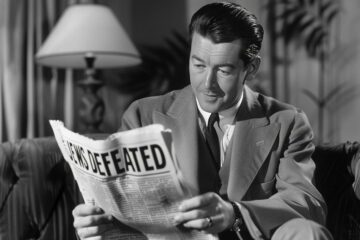Edutainment, part 4: Real versus Unreal
by Arthur Thief
Deep Protagonists, Cookie-Cutter Antagonists
WHENEVER THERE IS CONFLICT between characters on a screen or stage, be assured that the character most reflecting the “lessons” the creator of the piece wishes to teach will be the one most strongly thrust into the consciousness of the viewer and given the greatest amount of character development and expression.
On the other hand, any character or institution toward which the viewer is supposed to feel a sense of rejection, or even disgust and hatred, will be given only the most cursory exposition, communicating only enough of his ideals so that the viewer, when he rejects those ideals when triggered to do so by the background music or by the reactions of other characters, will know what he is rejecting.
How characters are introduced in a work, or even the naming of the work, gives us a strong indication of with whom we are to “identify.” From “Aladdin” to “Hamilton,” we know instantly who is the protagonist — for whom we are supposed to feel the most sympathy.
Consider the aforementioned character of Aladdin in the Disney animated film of the same name. He is a thief, a liar, a shallow teenager, and has little to commend him as a protagonist. Only two acts of kindness are attributed to him in the entire ninety minutes of the film — sharing his stolen bread with other street urchins, and freeing his friend, the Genie — and we are given only the assurance of a “magical cave” that he is a “diamond in the rough” — and yet a viewer does indeed reflexively focus upon him as the protagonist: He has titular pride of place, is obviously the main character, and is given an extensive musical introduction.
In the “romantic comedy” genre often favored by women, especially White women, this effect is used repeatedly. The main characters’ emotions and personalities are given more depth and thus more opportunity to arouse the sympathy of the viewer compared to those of other characters. What sane woman would identify with, or even wish to be associated as having anything in common with, the alcoholic, hedonistic, self-centered, and self-sympathizing failure of a human being that is Bridget Jones in the “Bridget Jones’ Diary” films? Yet make her a “star” — that is, make her almost constantly on the screen, and tell the entire story from her point of view, give her (eventually) a glamorous life and many wealthy suitors, focus the attention of the viewer constantly upon her, and have her played by an adorable actress of Norwegian-Swiss ancestry, Renee Zellweger — and what woman wouldn’t want to be her? After establishing that bond with the target audience, the character will, of course, then proceed to say all the “right” things and hold all the “right” sentiments that the Jewish producers would wish a White woman to say and believe.
We are supplied from cradle to grave with an endless stream of fictional people who, in light of cold reason, are horrible people with reality-rejecting and subversive ideals. We only accept these people as heroes, heroines, and “good people” because a careful web of visual tone, music, descriptive focus, and writing structure manipulates our emotions and seats them upon a pedestal of sympathy. From there, we accept “their” values as our own, and their beliefs and ideals find their way into our own thinking. At the same time, we are given antagonists who — by committing the most atrocious acts, or simply by wearing an dread-inspiring costume in a scene set to ominous theme music, or simply by being opposed to the main character — are identified as “villains.” The lines these antagonists utter consist of cartoonishly exaggerated are not-so-subtly veiled versions of what we non-Jews are not even supposed to think, much less say — causing us, the producers of this “entertainment” hope, to reject ideas that may be firmly rooted in observable reality simply because they are those of the villain.
Our ideals of “right” and “wrong” ought to be the result of careful and judicious examination of reality by our best minds, coupled with the inner urgings of our race-soul. But, too often today, our core subconscious values are instead those built up by a lifetime of emotional manipulation by tawdry entertainers.
Conclusions
My purpose herein has not been to catalogue every means by which entertainment is a vehicle for propaganda but, rather, to explore the more subtle ways — background details and visual framing, music, emotional response modelling, story structure and “screen-time” — in which the values of the real behind-the-scenes “entertainer” are transmitted to and absorbed by the consumer. A full exposé showing how these subtle tools have been used in every movie, popular song, novel, scholarly work, television show, or news broadcast would take hours of analysis of each example, and the work would exceed the size of the largest encyclopedia. However, such specificity is not necessary. The examples chosen here were or are immensely popular in their time, generally dismissed as “mindless” (or, some might charitably say, “innocent”) entertainment, and enjoyed by White children, women, and men across the globe.
What has been shown is that even the most tertiary of “entertainment industry” products have been carefully crafted, targeting Whites in particular, to disarm our natural moral and intellectual defenses, erode the values which not only led to our scientific and physical conquest of the world but even those which serve to perpetuate our very survival. The “lemmings” did not adopt these values on their own but rather have been subject to a lifetime bombardment of overt and subtle propaganda. The most effective tool in our enemies’ arsenal is not their control of the news media, school boards, or even the banks; rather it is entertainment with its subtle manipulations which has most deeply injected these destructive anti-White values in far too many Aryan minds.
Real Education: A Broad Scope Is Needed
A key plank in the long-term goals of the National Alliance is the establishment of a new system of education. However, anti-White inverted moral values have been rooted deeply in the subconscious of many of those we would seek to educate, including those who see themselves as “conservatives,” populists, libertarians, or other “rebels” against the status quo. This inverted morality was implanted in the mind below the level of rational thought using the emotional manipulations described above; no amount of facts or reason can easily unseat this, and indeed using facts and reason to contradict these self-destructive values has already been demonized in ten thousand scenes the average person has “experienced” by the time he reaches the age of 20.
An effective push for real education must include the production of quality, entertaining, and enjoyable cultural transmission as well, especially to provide emotional and subconscious reinforcement of our counter-propaganda. Indeed, as the enemy gets careless and his methods more overt, the anti-White (indeed, anti-Life) nature of his propaganda makes counter-propaganda more effective.
One activity of our Jewish would-be overlords which has repeatedly been called out on this site is human trafficking, especially of children. While this author has not yet seen and cannot fully comment upon the recently-released Sound of Freedom film in detail, and ergo whether the Christianity of those who created it has caused them to whitewash Jewish involvement in sex and other human slavery today, or trafficking’s especially heavy impact upon White nations (though the involvement and endorsement of Mel Gibson does give some faint hope on the former score at least), the very subject of the film and its subsequent success in light of the efforts to denigrate and even block viewing of it, shows that well-crafted entertainment counter-propaganda can be highly effective. A more pro-White, less philo-Semitic production could possibly prove even more effective. And, importantly, such entertainment could prove just as popular.
Edutainment is necessary, and it must be a project that spans the generations. No matter how much truth we share, no matter how clearly, many of our seeds of truth will die if they are sown in a mire of manipulated emotional responses.
Finis.
* * *
Source: Author







One example I can come up with offhand for showing the villain’s point of view so we can get a glimpse into his mindset is The Woodsman, starring Kevin Bacon as a child molester out on parole. His Jewish wife, Kyra Sedgwick stars as the adult female that he can legally have sex with. The main character has to answer to a black P.O. and a black secretary at his job tries to get him fired and he has a mestizo brother in law.
That sounds rather horrifying. From what you described they went and made the villain the main character. Do they try to get the audience to identify with him?
That they did. It was in first person form, and the villain eventually redeemed himself.